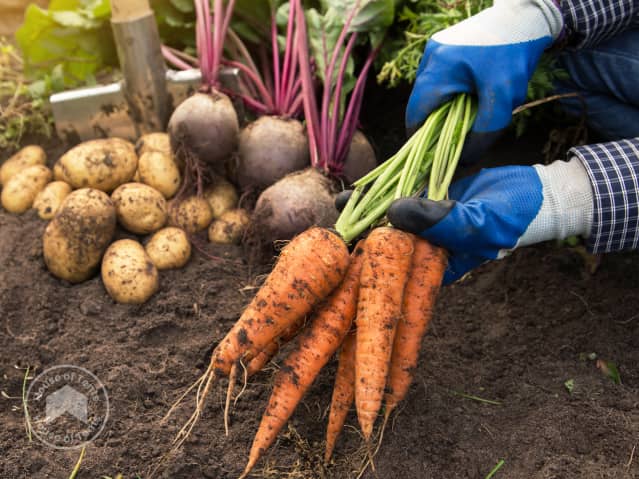
- Height 77 cm
- Flash
Once your raised bed has been built, it needs to be filled in such a way to create a nutrient-rich soil. But how do you fill a raised bed? Filling the raised bed with potting soil alone is not enough, as this soil alone doesn't promote rotting.
The solution is to fill your raised garden bed in layers. By creating different layers, the raised garden will generate its own heat, providing ideal conditions for the growth of your vegetables. The principle of filling the raised bed is very simple: you first fill the raised bed with coarse material and then get progressively finer as you move upwards. In the following instructions, we will show you in more detail one possibility for filling a garden bed.

We suggest filling the raised bed with 4 layers, to build up a healthy and productive raised bed soil mix:

Firstly, we recommend using a mix of tree cuttings, wood chips, and stones to fill the first layer of the raised bed. This layer serves as a loose foundation for the other individual layers, promoting sufficient drainage. Fill this layer up to a level 20-30 inches from the top of the bed, leaving space for the other layers, as well as 3-4 inches between the top of the soil and the top of the raised garden bed.
For the second layer, you can use a mix of garden waste and soil. You can use soil and from your garden to fill the raised bed and save yourself a trip to the DIY store. Grass clippings could be added to this layer if they are well-rotted. Well-rotted cuttings lack a strong smell and have changed in colour from green to brown. This layer should be anywhere between 3 - 6 inches thick.
The third layer should be made up of nutrient-rich organic material such as compost and manure. Make sure that your compost does not contain any meat or fish. If using manure, this should have been fully dried out before use. Worm castings, or vermicompost, are an excellent organic fertilizer rich in nutrients and beneficial microorganisms. They can be added to the compost layer in your raised garden bed. This compost layer should be between 4-6 inches thick.
Now for the finishing touch, the topsoil layer. For this layer you can use potting soil or organic black soil. This is where most vegetable roots exist. The layer should be around 8 inches thick. Once this layer is ready, you can start planting your garden bed - with vegetables, fruits, herbs or a selection of colourful flowers.
Our best selling hobby garden beds
Selecting the appropriate soil mix is crucial when establishing a raised garden bed, especially for optimal vegetable cultivation. The ideal raised bed soil mix should strike a balance between good drainage, aeration, and nutrient content. Our recommended approach involves layering the bed with a foundation of coarse materials like gravel for proper drainage, a layer of garden soil and garden matter, a layer of compost or well-rotted manure, and a top layer comprising high-quality topsoil. This approach creates a fertile ground for vegetables to thrive. Making the effort to build a high-quality raised bed soil mix not only supports healthy plant growth but also promotes water retention and effective weed management.
When incorporating homemade compost into a raised garden bed, it's essential to ensure that the compost is well-rotted to prevent any potential harm to plant roots from residual heat. Additionally, maintain a balanced mix by layering the compost with other organic matter, such as shredded leaves or straw, to enhance nutrient diversity and promote a healthier soil structure.
Mulch is applied on top of the soil, which insulates the soil, inhibits weed growth and releasing nutrients into the topsoil over time as it decomposes. Be mindful not to pile the mulch directly against plant stems, as this can trap moisture and create a favorable environment for pests or diseases to thrive
Topsoil is the uppermost layer of soil, typically the top 5 to 6 inches, where most plant roots grow and where the majority of organic matter is found. It is rich in nutrients and is crucial for plant growth.
It's important to use well-decomposed or aged manure as part of your garden bed soil. Fresh manure is high in nitrogen and can be too strong for young plants. Cow manure is a well-balanced and widely available option. Horse manure is readily availble, but may contain a large amount of unwanted weed seeds.
Perlite and pumice are natural, volcanic materials used in gardening and horticulture. The lightweight rocks improve aeration and drainage in a garden bed. They are commonly found in commercial potting mixes and are available for individual purchase as well.
Peat moss is a type of organic material derived from partially decomposed mosses, primarily sphagnum moss, found in waterlogged conditions like peat bogs and is sometimes used in gardening. It is excellent at retaining moisture within the garden, and is naturally acidic, which is useful for acid-loving plants such as blueberries and azaleas. Due to environmental concerns, many gardeners are exploring alternative soil amendments that are more sustainable.
Worm castings provide a slow-release source of essential nutrients for your plants and contribute to the overall fertility of the soil. Additionally, the beneficial microorganisms present in worm castings can enhance soil health and promote a thriving ecosystem for plant growth. Remember to use worm castings as a supplement rather than a primary component of the mix. While they are nutrient-rich, they work best when combined with other organic materials to create a well-balanced soil environment for your plants.
Our best selling standard raised garden beds
To find out how much soil you need for your raised bed, first measure the dimensions of the bed. You will need to convert all measurements to the same unit of measurement. We recommend using cubic metres, which allows for an easy conversion to litres. If you are buying soil by the cubic foot or cubic yard, you may find it easier to measure your raised bed in imperial measurements.
To find the amount of soil or organic matter required for each layer in cubic metres, multiply the area of the raised bed by the height of that layer. To convert to litres, multiply by 1000.
For example, we recommend using 8 inches of top soil in a garden bed. That's roughly 20 cm. In a 119 cm by 119 cm raised bed, you would need 1.19 x 1.19 x 0.2 = 0.28 cubic metres, equivalent to 0.28 x 1000 = 280 litres.
Having trouble with your calculations? Our team of product experts are happy to assist. They are available to answer all your questions relating to raised garden beds, and can suggest the best accessories and product lines for your particular needs.
Expert advice
